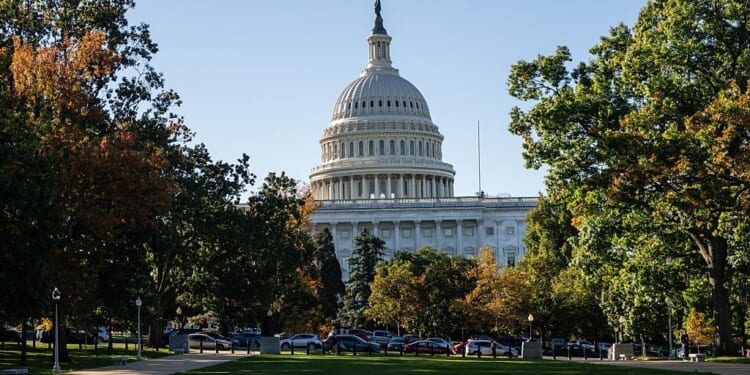The House passed a continuing resolution to prevent the federal government shutdown before it even began. But it did so on a party-line vote with the support of just one Democrat, Jared Golden of Maine. For nearly a month, both sides of the aisle in both chambers of Congress have remained resolute in their respective stances – now, however, things are beginning to change. Democrats appear on the cusp of compromise, but will Senate Republicans join them, or find a more nuclear way to end the shutdown?
A New Offer Emerges
The Senate reconvenes today, October 27, at 3 p.m., and one of its first orders of business will likely be addressing the almost month-long government shutdown. There’s a continuing resolution on the table, but Democrats in general won’t get behind it. It was passed almost exclusively by the House GOP, and while almost all Republicans and a few Democrats in the Senate have consistently voted in its favor, the stopgap funding bill just can’t seem to garner the required 60 votes to break the filibuster and force a final ballot on the issue.
As the November 1 deadline by which a handful of federal benefit programs will lose funding looms right around the corner, one Senate Democrat has proposed a compromise. Democratic leadership has demanded a permanent extension of the enhanced ACA subsidies that were issued as a response to the COVID-19 pandemic. They also required a reversal of Trump and GOP-backed Medicaid reforms. All told, it would cost an estimated $1.5 trillion over the next decade. But Sen. Chris Murphy (D-CT) told CNN’s State of the Union on Sunday that enough Democrats would probably get behind ending the shutdown for about $20 billion.
“We could probably come up with something pretty quick,” the Connecticut lawmaker said. “The president just announced $20 billion going to bail out the Argentinian economy. For $20 billion, we could open the government back up. That’s enough money to relieve a lot of pressure. We can get this deal done in a day.”
The current “clean” continuing resolution would reopen the government and keep it funded through November 21. It’s unclear whether Sen. Murphy’s $20 billion suggestion represents the cost for a single year or ten, or if the rest of his party would even back it either way. That said, Republicans just need five Democrats to cross the aisle, not the whole group.
Government Shutdown or Senate Tradition: Which Ends First?
Republicans have expressed an openness to discussing an extension of the enhanced subsidies, but that would have to come with reforms. Senate Majority Leader John Thune (R-SD) even promised this month to guarantee a vote on it – once the government reopens as a result of the clean resolution already on the table, that is.
As the late Herman Cain used to say, the devil is in the details. Whether a bipartisan group of senators really could hammer out a $20 billion addition to the shutdown resolution that satisfies enough of both parties to actually clear the 60-vote hurdle in the Senate remains to be seen. As well, it would then have to pass in the House – a body far less known for compromise between the two parties.
There is one more way the Senate could end the shutdown as quickly as this week, however, but its ramifications spread far beyond next year’s funding: the nuclear option.
To say that votes in the Senate require a three-fifths vote is something of an oversimplification. Just as in the House, the final passage of a bill only requires a simple majority. The problem, however, has always been when and how to end debate and force a final vote. Prior to 1806, the method was the previous question motion. It was intended to cut off debate, but it was flawed. The motion itself was debatable, and folks started using it as a way to prolong debates rather than shorten them.
Throughout the 19th century, the use of perpetual debate to delay or stop legislation – which took on the moniker “filibuster” in the 1850s – grew. In 1917, the Senate adopted the cloture rule, which allows debate to be ended by a two-thirds vote. That was eventually reduced to a three-fifths majority in 1975. Once cloture has successfully been invoked, the final vote on the bill itself requires a simple 50% plus one. Thus was born the Senate’s legislative process as we know it today.
Well, sort of. You see, this rule applied to bills and nominations alike. But by 2013, the filibuster was being used too frequently to prevent the majority party from getting its way. Or, at least, that seemed to be the opinion held by then-Senate Majority Leader Harry Reid (D-NV). Frustrated by Republicans blocking the confirmation of President Obama’s nominees, Reid chose what’s frequently called “the nuclear option.” In short, he used a procedural loophole to force a change in the Senate’s rules by simple majority, killing the filibuster on most presidential nominations.
Slippery Slope?
Fast forward to 2017, and President Trump was experiencing the same issue with his Supreme Court nominee, Neil Gorsuch. Mitch McConnell (R-KY), the Senate’s majority leader at the time, pulled a Reid and removed the filibuster for Supreme Court confirmations, as well. Now all that remains is the legislative filibuster – the 60-vote rule for actual bills. Democrats tried to nuke it numerous times throughout the Biden presidency, but two senators, Kyrsten Sinema of New York and Joe Manchin of West Virginia, refused to toe the party line.

Today, at least a couple of Republicans are considering the nuclear option. “If we can’t get anything done, that’s what [Democrats] are gonna force,” Sen. Rick Scott (R-FL) said of ending the filibuster last week, seemingly resigned to the inevitability of it. Sen. Josh Hawley (R-MO) told reporters he wasn’t “willing to see children in my state go hungry … over some Senate procedure.”
Will Republicans opt to end the filibuster entirely rather than pass a new resolution that includes permanent extensions of the emergency ACA subsidies? It seems like a drastic measure – because it is – but it also may very well be inevitable. Only two moderate Democrats protected the filibuster in the previous Congress, and now they’re gone. The current Democratic leadership was willing on multiple occasions to go nuclear over legislation central to the party platform – so what’s to stop that from happening as soon as they’re in power again?
The party that kills the filibuster while holding both chambers of Congress and the White House gets first crack at using its majorities to ramrod through whatever legislative agenda it wants, no matter how extreme. But once they open that door, it will likely never close again. Still, the filibuster has been dying a slow death since Harry Reid made the first cut. It seems inevitable that, eventually, some perceived crisis or another will be the final nail in the coffin. The question now is whether a deal can be made to end the shutdown first.















